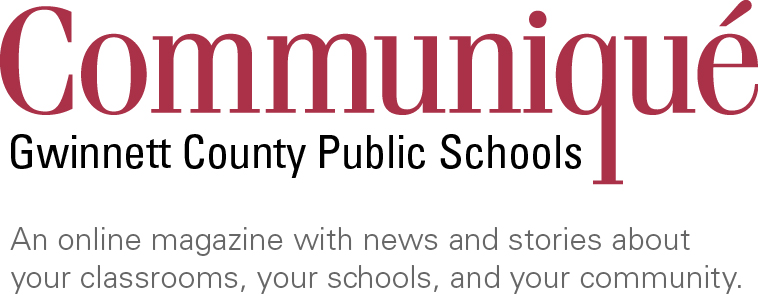Learning to play is serious business, because playing to learn has an important role in preparing children for kindergarten.
Gwinnett County Public Schools is in Year Five of an early childhood initiative called Play 2 Learn that helps young children and their parents—a child’s first and best teachers—make the most of their time together to lay a foundation for a lifetime of learning.
“Studies show that children who are not ready to learn when they come to kindergarten— about half of Gwinnett kindergartners— have a greater chance of falling behind and staying behind in school,” says Kim Holland, director of GCPS’ Office of Early Learning and School Readiness. “Play 2 Learn helps families develop and practice skills to support their young kids so they will be better prepared for school success. More importantly, Play 2 Learn helps build a connection between children and their parents and their shared love for learning.”
So why is early learning and a strong learning foundation so important? Around 3rd grade, children typically transition from learning to read to reading to learn. A child who is not reading on grade level at grade 3 will continue to struggle with reading but also will get behind in science, social studies, even math, because reading is such an important element across the curriculum. And, a student who gets behind may never catch up, increasing the likelihood of dropping out and decreasing opportunities for success in adulthood.
Currently, 42 GCPS elementary schools offer the program for families of young children, from babies and toddlers to pre-K. With current pandemic precautions, families have the option to attend an hour-long, in-person session each week or participate in a 30-minute digital session.
“With Play 2 Learn, children, parents, and other adults in the family learn together through engaging lessons each week during the school year,” says Ms. Holland. However, the learning doesn’t stop there!
Specially trained teachers guide families through activities they can do at home and everyday opportunities to reinforce the building-block skills that prepare children for kindergarten. For instance, videos model how to read aloud to young kids and tipsheets give families ways to play and learn with markers, safety scissors, and Play-doh. (Participating families receive some at-home materials like crayons, glue, paper, etc.) For families that elect the digital learning option, donated hot spots and tablets may be available to check out if needed.
On the Play 2 Learn website, families can find great resources—in English and in Spanish—to support their baby or toddler’s early learning. Resources include:
Whether families participate at school or via the digital option, the focus is on hands-on activities and the intentional, everyday interaction between children and the adults in their lives. These positive interactions help build vocabulary and experiences that children will draw on once they are in school.
For instance, a trip to the grocery store is a great time to talk about colors and letters, count items as they are added to the cart, point out shapes and compare items. “Look at the two orange pumpkins! One is big and one is small. Which one is bigger? Let’s count the red apples as we put them in our bag. Your name starts with a T. Do you see a T in this sign? This box of cereal is a rectangle. What shape is the top of that can?”
“Play 2 Learn opens up a child’s brain for more learning,” says Chris Stanford, who works with the program at Winn Holt ES. “They’re getting a rich learning environment through the program, and a routine.” Ms. Stanford, a former kindergarten teacher, says that Play 2 Learn helps children learn school expectations. As a result, children are more ready to learn once they get to school. Can they sit? Can they interact with other kids? Can they listen? Are they used to being read to? “School’s not a fearful thing,” she says.
The program also prepares the adults for their child’s move to “big school,” says Ms. Stanford. “They gain knowledge about how schools run, expectations in the classroom, and what happens during the school day,” she says “They also gain trust that teachers are doing their best with their children.”
And, parents learn how the things they do at home every day can help their child get ready for school. After all, they are their child’s first and best teacher!
Check out this video from GCPS TV to learn more about the benefits of Play 2 Learn. (The video was produced prior to current COVID-19 precautions.)
Did you know that only 48% of children in our community start school prepared to learn? Earlier this month, the Gwinnett County Community Early Learning Working Group launched an early learning awareness campaign and new web-based resources for families to make sure children are ready to thrive in kindergarten and beyond. The campaign is part of a broader countywide strategy to improve Kindergarten Readiness. Called Gwinnett Building Babies’ Brains, this initiative is critical to our community’s success. Research shows that children exposed to positive early learning experiences—like reading, singing, and talking with caregivers—are less likely to have academic and behavioral problems in school. They are more likely to be strong readers by 3rd grade and graduate from high school.
Learn more about brain development in children under the age of 5 and build an online toolkit with age-specific resources. To keep up with the latest on this initiative, follow Building Babies’ Brains on Facebook and Instagram, and sign up for the newsletter.
More Early Learning Resources for Families
GCPS’ Early Learning board on Pinterest
12 Ways to Support School-Readiness for Young Learners, a Daily Dozen tipsheet in Communiqué
Important milestones at ages 2 months, 4 months, 6 months, 9 months, 1 year, 2 years, 3 years, 4 years, and 5 years
Popular books for young readers and bedtime math
Resources from Zero to Three, Vroom, PBS Kids, Atlanta Speech School, and Ready4KGA







